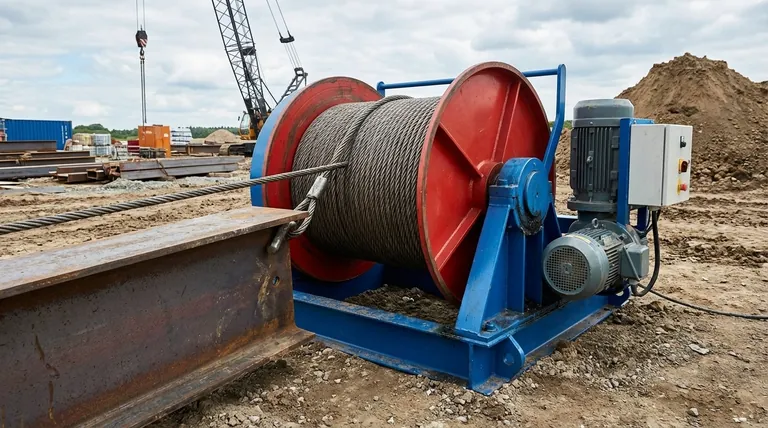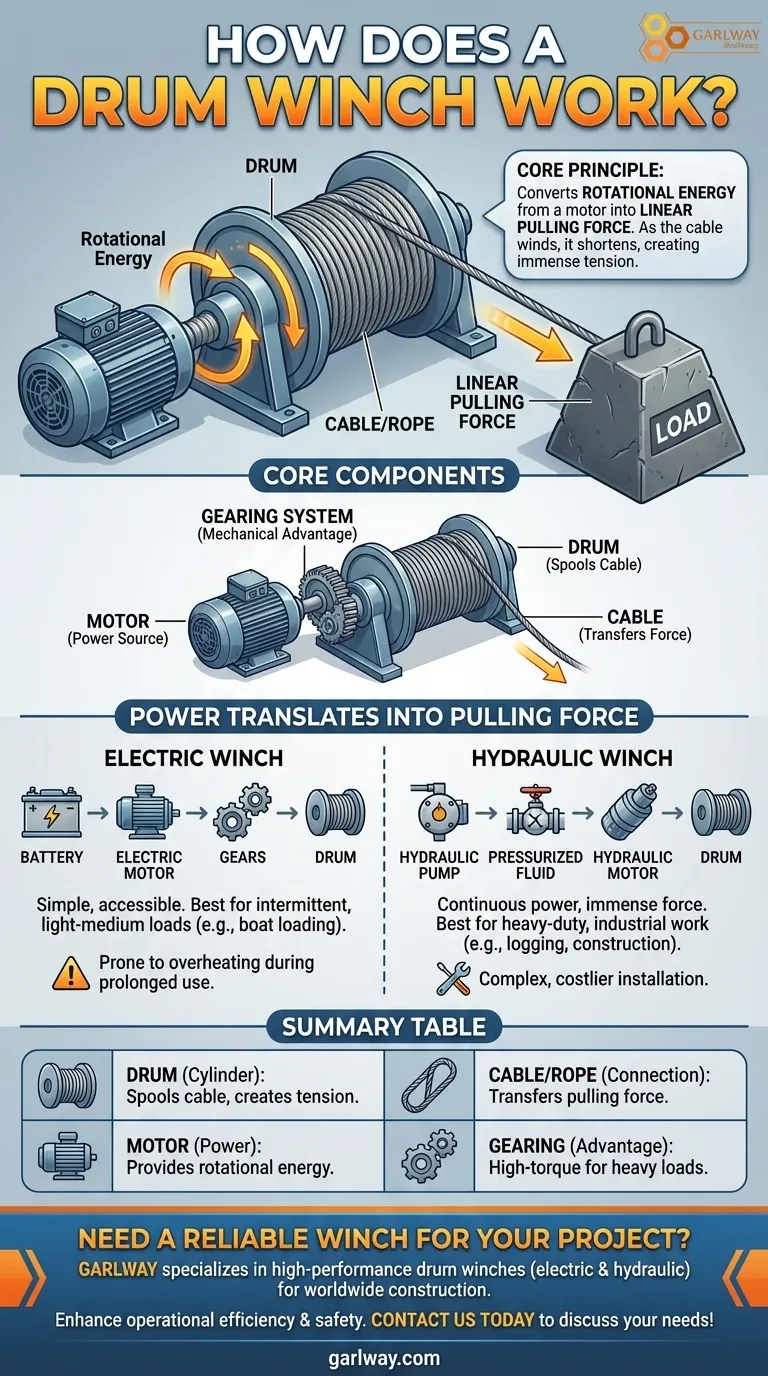At its core, a drum winch works by a simple, powerful principle: it converts rotational energy from a motor into linear pulling force. The motor turns a cylindrical drum, which winds a cable or rope around its surface. As the cable wraps onto the drum, it shortens, creating immense tension that pulls or lifts the attached load.
A drum winch is a force multiplier. It uses a power source, like an electric motor or hydraulic system, to rotate a drum, which methodically wraps a cable to generate the high-tension pulling force needed to move heavy objects.

The Core Components of a Drum Winch
To understand the operation, it's essential to recognize the function of each key part. Every drum winch, regardless of its power source, is built around these fundamental components.
The Drum: The Heart of the Operation
The drum is the central cylindrical component that stores and spools the cable. It is a simple tube, typically with flanges on each side to prevent the cable from slipping off.
The drum rotates in both directions, allowing the cable to be either wound in (to pull a load) or spooled out (to release it). Its physical dimensions—diameter and length—dictate the winch's cable capacity.
The Cable or Rope: The Point of Connection
The cable is the medium that transfers the pulling force from the winch to the load. One end is securely fastened to the drum, while the other end connects to the object you intend to move.
As the drum turns, the tension created in the cable does the actual work.
The Powertrain: The Source of Force
A motor provides the rotational power needed to turn the drum. This is where the primary distinction between winch types emerges, with the most common being electric and hydraulic systems.
How Power Translates into Pulling Force
The specific mechanism for generating force depends on the type of motor used. Each has a distinct method for turning the drum.
The Electric Winch
An electric winch uses an electric motor, often powered by a 12-volt battery. When the operator pushes a button, electricity flows from the power source to the motor.
The motor engages, turning a series of gears which then rotate the drum. This gearing provides a mechanical advantage, allowing a small, high-speed motor to generate the low-speed, high-torque rotation needed to pull heavy loads.
The Hydraulic Winch
A hydraulic winch operates on the principle of fluid dynamics. It uses a hydraulic pump to pressurize a specialized fluid.
This pressurized fluid is then directed into a hydraulic motor connected to the winch drum. The force of the fluid drives the motor, causing the drum to rotate with significant and consistent power. A control valve manages the flow of fluid, allowing the operator to start, stop, and reverse the winch's direction.
Understanding the Trade-offs: Electric vs. Hydraulic
While the outcome is the same—pulling a load—the choice between an electric and hydraulic system is driven by the application's demands. Understanding their inherent differences is key to choosing the correct tool.
When to Choose Electric
Electric winches are valued for their simplicity and accessibility. They are generally easier to install, especially in vehicles or boats where a battery is already present.
However, they can be prone to overheating during prolonged, heavy use and their power is limited by the capacity of the battery and electrical system. They are ideal for intermittent, lighter-duty tasks.
When to Choose Hydraulic
Hydraulic winches are the workhorses of industrial applications. They can run continuously without overheating and generate immense, sustained pulling force.
Their primary trade-off is complexity. They require a hydraulic pump and associated lines, making installation more involved and costly. They are best suited for heavy-duty, commercial, or recovery operations where reliability under extreme load is non-negotiable.
Making the Right Choice for Your Application
Your final decision should be guided by the specific task you need to accomplish.
- If your primary focus is convenience and light-to-medium loads: An electric winch offers a straightforward, effective, and cost-efficient solution for tasks like loading a boat onto a trailer or light vehicle recovery.
- If your primary focus is continuous power for heavy-duty industrial work: A hydraulic winch provides the uncompromising force and durability required for commercial towing, logging, or major construction jobs.
- If your primary focus is understanding the basic mechanics: Remember that all drum winches share the core principle of converting a motor's rotation into the linear force needed to do work.
By understanding these core principles, you can confidently select and operate the right winch for any task.
Summary Table:
| Component | Function |
|---|---|
| Drum | Cylinder that spools the cable, creating tension. |
| Cable/Rope | Transfers the pulling force from the winch to the load. |
| Motor (Electric/Hydraulic) | Provides the rotational power to turn the drum. |
| Gearing System | Provides mechanical advantage for high-torque pulling. |
Need a Reliable Winch for Your Project?
GARLWAY specializes in high-performance construction machinery, offering durable drum winches perfect for construction companies and contractors worldwide. Whether you need the simplicity of an electric winch or the continuous power of a hydraulic system, we have the solution to enhance your operational efficiency and safety.
Contact us today to discuss your specific needs and let our experts help you select the perfect winch!
Visual Guide

Related Products
- Best 18000 Pound Drum Anchor Trailer Winch
- Ready Mixer Machine for Construction Ready Mix Machinery
- Electric and Hydraulic Winch for Heavy Duty Applications
- Commercial Construction Mixer Machine for Soil Cement Mixing Concrete
- Warn Winch Windlass Boat Trailer Winch
People Also Ask
- How do trailer winches benefit boat owners? Achieve Safe & Effortless Boat Loading
- How are trailer winches rated? A Guide to Safe & Effective Load Capacity
- How are trailer winch sizes determined? Match Capacity to Your Boat's Weight for Safe Loading
- What is the primary function of trailer winches? Effortlessly Load Heavy Boats & Equipment
- What is the significance of trailer winches in the boating industry? Ensure Safe and Efficient Boat Recovery

















